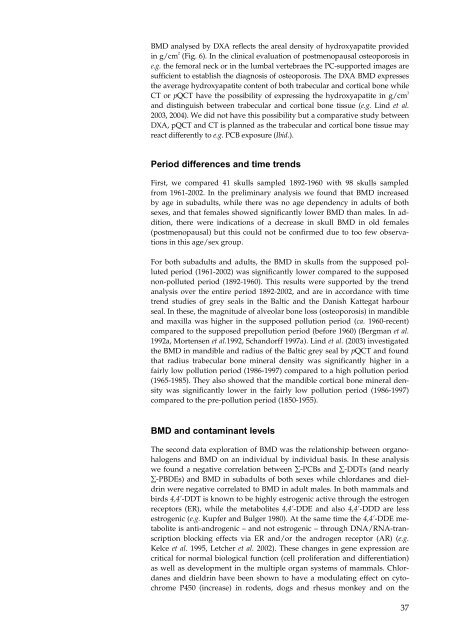Organohalogen concentrations and a gross and histologic ...
Organohalogen concentrations and a gross and histologic ...
Organohalogen concentrations and a gross and histologic ...
You also want an ePaper? Increase the reach of your titles
YUMPU automatically turns print PDFs into web optimized ePapers that Google loves.
BMD analysed by DXA reflects the areal density of hydroxyapatite provided<br />
in g/cm 2 (Fig. 6). In the clinical evaluation of postmenopausal osteoporosis in<br />
e.g. the femoral neck or in the lumbal vertebraes the PC-supported images are<br />
sufficient to establish the diagnosis of osteoporosis. The DXA BMD expresses<br />
the average hydroxyapatite content of both trabecular <strong>and</strong> cortical bone while<br />
CT or pQCT have the possibility of expressing the hydroxyapatite in g/cm 3<br />
<strong>and</strong> distinguish between trabecular <strong>and</strong> cortical bone tissue (e.g. Lind et al.<br />
2003, 2004). We did not have this possibility but a comparative study between<br />
DXA, pQCT <strong>and</strong> CT is planned as the trabecular <strong>and</strong> cortical bone tissue may<br />
react differently to e.g. PCB exposure (Ibid.).<br />
Period differences <strong>and</strong> time trends<br />
First, we compared 41 skulls sampled 1892-1960 with 98 skulls sampled<br />
from 1961-2002. In the preliminary analysis we found that BMD increased<br />
by age in subadults, while there was no age dependency in adults of both<br />
sexes, <strong>and</strong> that females showed significantly lower BMD than males. In addition,<br />
there were indications of a decrease in skull BMD in old females<br />
(postmenopausal) but this could not be confirmed due to too few observations<br />
in this age/sex group.<br />
For both subadults <strong>and</strong> adults, the BMD in skulls from the supposed polluted<br />
period (1961-2002) was significantly lower compared to the supposed<br />
non-polluted period (1892-1960). This results were supported by the trend<br />
analysis over the entire period 1892-2002, <strong>and</strong> are in accordance with time<br />
trend studies of grey seals in the Baltic <strong>and</strong> the Danish Kattegat harbour<br />
seal. In these, the magnitude of alveolar bone loss (osteoporosis) in m<strong>and</strong>ible<br />
<strong>and</strong> maxilla was higher in the supposed pollution period (ca. 1960-recent)<br />
compared to the supposed prepollution period (before 1960) (Bergman et al.<br />
1992a, Mortensen et al.1992, Sch<strong>and</strong>orff 1997a). Lind et al. (2003) investigated<br />
the BMD in m<strong>and</strong>ible <strong>and</strong> radius of the Baltic grey seal by pQCT <strong>and</strong> found<br />
that radius trabecular bone mineral density was significantly higher in a<br />
fairly low pollution period (1986-1997) compared to a high pollution period<br />
(1965-1985). They also showed that the m<strong>and</strong>ible cortical bone mineral density<br />
was significantly lower in the fairly low pollution period (1986-1997)<br />
compared to the pre-pollution period (1850-1955).<br />
BMD <strong>and</strong> contaminant levels<br />
The second data exploration of BMD was the relationship between organohalogens<br />
<strong>and</strong> BMD on an individual by individual basis. In these analysis<br />
we found a negative correlation between ∑-PCBs <strong>and</strong> ∑-DDTs (<strong>and</strong> nearly<br />
∑-PBDEs) <strong>and</strong> BMD in subadults of both sexes while chlordanes <strong>and</strong> dieldrin<br />
were negative correlated to BMD in adult males. In both mammals <strong>and</strong><br />
birds 4,4’-DDT is known to be highly estrogenic active through the estrogen<br />
receptors (ER), while the metabolites 4,4’-DDE <strong>and</strong> also 4,4’-DDD are less<br />
estrogenic (e.g. Kupfer <strong>and</strong> Bulger 1980). At the same time the 4,4’-DDE metabolite<br />
is anti-<strong>and</strong>rogenic – <strong>and</strong> not estrogenic – through DNA/RNA-transcription<br />
blocking effects via ER <strong>and</strong>/or the <strong>and</strong>rogen receptor (AR) (e.g.<br />
Kelce et al. 1995, Letcher et al. 2002). These changes in gene expression are<br />
critical for normal biological function (cell proliferation <strong>and</strong> differentiation)<br />
as well as development in the multiple organ systems of mammals. Chlordanes<br />
<strong>and</strong> dieldrin have been shown to have a modulating effect on cytochrome<br />
P450 (increase) in rodents, dogs <strong>and</strong> rhesus monkey <strong>and</strong> on the<br />
37

















